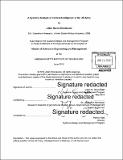| dc.contributor.advisor | Jayakanth Srinivasan. | en_US |
| dc.contributor.author | Wisniewski, Jillian Marie | en_US |
| dc.contributor.other | Massachusetts Institute of Technology. Engineering Systems Division. | en_US |
| dc.coverage.spatial | n-us--- | en_US |
| dc.date.accessioned | 2017-01-06T16:13:01Z | |
| dc.date.available | 2017-01-06T16:13:01Z | |
| dc.date.copyright | 2015 | en_US |
| dc.date.issued | 2015 | en_US |
| dc.identifier.uri | http://hdl.handle.net/1721.1/106231 | |
| dc.description | Thesis: S.M. in Engineering and Management, Massachusetts Institute of Technology, School of Engineering, System Design and Management Program, Engineering and Management Program, 2015. | en_US |
| dc.description | Cataloged from PDF version of thesis. | en_US |
| dc.description | Includes bibliographical references (pages 101-103). | en_US |
| dc.description.abstract | This thesis explores drivers of mission performance outcomes through dynamics associated with intelligence and operational processes. System dynamics methodology can provide a foundation for exploration of these processes within the intelligence cycle. In the Army's current structure, intelligence capacity falls short of what combat battalions need in the modern operational environment. Is this shortfall a remnant of an archaic design, or has the intelligence process itself changed so significantly that the drivers of intelligence capacity require revision? There has been a significant structural transformation of Army units over the past two decades. This has also impacted the intelligence community both within and outside of the Army. Advances in information technology have resulted in a prodigious increase in collection platforms, digital data streams, and digital architecture at the tactical level. These transformations have significantly changed the nature of tactical intelligence analysis and therefore necessitate an appreciative update to analyst capabilities. A scrutiny of the analyst's role in unit operations reveals four major components of competency that are imperative to analysts' abilities. Design structure matrices reveal the relationship of these components across 132 competency specifications from Army doctrine, and expose performance challenges from lack of proficiency within information processing methodologies. A system dynamics model exposes the cost of analyst performance shortfalls. It is proven that increased reliance on shortcut methods erodes analysts' ability to improve skillsets, which in turn is detrimental to the Army's intelligence community and may impair overall future US military combat capability. Considered paths to improvement are discussed. | en_US |
| dc.description.statementofresponsibility | by Jillian Marie Wisniewski. | en_US |
| dc.format.extent | 117 pages | en_US |
| dc.language.iso | eng | en_US |
| dc.publisher | Massachusetts Institute of Technology | en_US |
| dc.rights | M.I.T. theses are protected by copyright. They may be viewed from this source for any purpose, but reproduction or distribution in any format is prohibited without written permission. See provided URL for inquiries about permission. | en_US |
| dc.rights.uri | http://dspace.mit.edu/handle/1721.1/7582 | en_US |
| dc.subject | Engineering and Management Program. | en_US |
| dc.subject | System Design and Management Program. | en_US |
| dc.subject | Engineering Systems Division. | en_US |
| dc.title | A systems analysis of tactical intelligence in the US Army | en_US |
| dc.type | Thesis | en_US |
| dc.description.degree | S.M. in Engineering and Management | en_US |
| dc.contributor.department | Massachusetts Institute of Technology. Engineering and Management Program | en_US |
| dc.contributor.department | System Design and Management Program. | en_US |
| dc.identifier.oclc | 961332622 | en_US |
